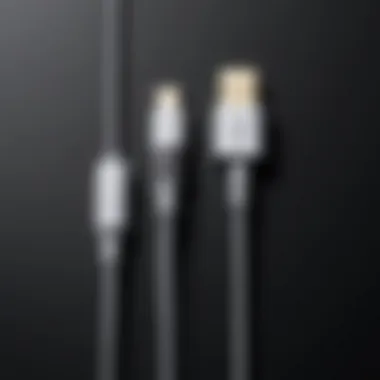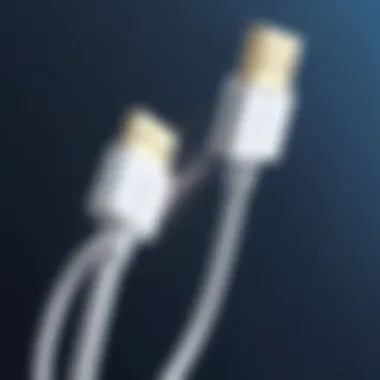Uncovering the Strongest iPhone Lightning Cable Features


Intro
As mobile devices become more integral to our daily lives, the need for reliable accessories increases. One such accessory is the iPhone lightning cable. Understanding the factors contributing to the strength and durability of these cables is crucial for users seeking the best options available. This analysis aims to explore various aspects of lightning cables, including materials, certifications, and performance metrics. By examining reputable brands and user experiences, readers will be better prepared to select a cable that meets both durability and functionality needs.
Overview of the Product
Purpose and Benefits
The strongest iPhone lightning cable serves multiple purposes beyond simple charging. It allows for data transfer, device synchronization, and efficient power delivery. The benefits include sturdy construction, which reduces the likelihood of fraying and damage over time. Additionally, the latest technology in cable design ensures optimal charging speeds, maximizing device performance.
Target Audience
Target audiences for this analysis primarily include tech enthusiasts, gamers, and computer builders. These groups often demand high-quality accessories that can withstand frequent use and potential wear and tear. Understanding the details of lightning cables helps them make informed purchases that suit their lifestyle and usage patterns.
Key Features
When evaluating the strongest iPhone lightning cable, several key features stand out:
- Material Quality: Look for cables with reinforced connectors and durable outer sheaths.
- Data Transfer Speeds: Quick transfer speeds are essential for gamers and professionals.
- Compatibility: Ensure the cable supports various Apple devices, from iPhones to iPads.
Technical Specifications
Detailed Product Specs
The strongest iPhone lightning cables usually boast specifications such as:
- Length options commonly range from one to six feet.
- Compatibility with Apple’s latest devices.
- Power delivery up to 20W for faster charging.
Performance Benchmarks
Performance metrics are critical. It is essential to test how many times a cable can be plugged and unplugged without losing efficacy. High-grade cables should withstand at least 5,000 bends without failure.
Comparison with Similar Products
Market Competitors
Several brands stand out in the lightning cable market, including Anker, Belkin, and Apple. Each brand offers unique advantages, from durability to speed features.
Comparative Analysis
When comparing cables, consider factors like:
- Price: Higher price often correlates with better quality, but it is not always the case.
- Warranty: Brands that offer warranties often stand behind their products.
Best Use Cases
For regular charging, a basic durable cable suffices. However, professional gamers or heavy users should consider high-end cables designed for extensive usage.
Installation and Setup Guide
Requirements for Installation
Installing a lightning cable is straightforward, requiring only the cable and a compatible device. Always ensure your device's software is updated for optimal cable performance.
Step-by-Step Process
- Connect the Lightning Cable: Take one end and plug it into the device.
- Connect to Power Source: Insert the USB end into an adapter or computer.
Tips for Optimizing Setup
- Avoid twisting or reinforcing the cable unnecessarily.
- Store the cable coiled rather than bent sharply to prevent damage.
Help Sections and Troubleshooting
Common Issues and Solutions
Many users complain about fraying or malfunctions.


- Solution: Invest in cables with reinforced connectors to prevent such issues.
Expert Tips
Regularly clean the connectors to avoid build-up that might affect charging speed.
“Choosing the right lightning cable can significantly enhance the functionality and lifespan of your device.”
Overview of Lightning Cables
Understanding Lightning cables is essential for anyone utilizing Apple devices. Their functionality and durability can significantly affect user experience. It's not only about connectivity but also the longevity and reliability of the connection. The Lightning cable serves as a vital link between an iPhone and its power source or computer. Therefore, choosing the right cable can prevent unnecessary frustrations.
Defining Lightning Cable Technology
Lightning cable technology is centered around a compact, reversible connector design introduced by Apple in 2012. Unlike previous connectors, the Lightning connector can be plugged into a device in either orientation. This may seem trivial, but it vastly improves user convenience. The cables are often equipped with a digital signal processor integrated into the connectors. This design enables the cable to optimize the power delivered, preventing overheating and increasing charging efficiency.
Lightning cables also support seamless data transfer between devices. This is especially important for users working with large files or performing backups. The technology has evolved to maintain compatibility across a wide range of Apple products, from iPhones to iPads to various accessories.
Evolution of Lightning Connector
The Lightning connector has undergone notable refinements since its inception. Initially, it was introduced to replace the 30-pin dock connector. This change was part of Apple's strategy to create a more streamlined design compatible with modern devices. The shift not only reduced the size of the connector but also enhanced functionality.
Over the years, Apple has continued to improve the quality and performance of its Lightning cables. Early iterations presented durability issues, prompting the company and third-party manufacturers to invest in stronger materials and better construction techniques. Today’s Lightning cables are built to endure regular wear and tear while maintaining high performance standards.
The design evolution of the Lightning connector reflects Apple's commitment to user experience and technological advancement.
Importance of a Strong Lightning Cable
Strong Lightning cables are crucial for modern iPhone users, as they directly affect performance, longevity, and overall user satisfaction. In an era where digital connectivity is essential, finding a reliable cable goes beyond simple convenience. Instead, it involves understanding the material quality, charging speed, and compatibility with various devices. Each aspect can significantly impact the user experience and, further, device functionality.
Durability and User Impact
Durability in a Lightning cable refers to its ability to withstand daily wear and tear. Users often find that cheaper cables tend to fray or break more quickly, leading to frustration and additional costs. The user impact of a durable cable extends beyond just its physical integrity. A resilient cable can result in increased productivity, as it minimizes the frequency of replacements.
Taking the potential downtime caused by a failing cable into account, the costs of poor durability can be substantial. Users who need to charge devices frequently, like gamers or professionals, stand to benefit more from investing in robust cables. Studies show that users report better satisfaction rates and longer service life when employing strong cables, enhancing the overall experience.
Charging Speed Considerations
Charging speed is another critical consideration when choosing a Lightning cable. Different cables offer varying levels of performance, and understanding these nuances is essential. High-quality cables can support fast charging, allowing devices to recharge significantly quicker than low-quality alternatives.
Apple's specifications indicate that their cables, particularly those that meet MFi standards, are capable of faster speeds. Their advantage lies in greater amperage management, which allows more current to flow safely. Ignoring the charging speed could lead to inconvenient delays, particularly for users who rely heavily on their devices throughout the day.
Compatibility with Devices
Compatibility with a wide range of devices remains an important aspect of any Lightning cable. Not all cables are created equal, and their performance can differ based on specific device requirements. Strong cables are often designed to work seamlessly with various generations of iPhone and other Apple products.
Moreover, a versatile cable can serve multiple purposes, connecting to different devices within the Apple ecosystem. This feature ensures maximum usability for the consumer. It is reassuring for users to know that their chosen cable will support not only their iPhones but also devices like the iPad or AirPods.
The importance of a strong Lightning cable cannot be overstated. It affects durability, charging speed, and compatibility, crucial for any tech-savvy individual.
Materials Used in Lightning Cables
The materials used in lightning cables play a crucial role in determining their performance, durability, and reliability. Understanding these various components is necessary for evaluating the strength and efficiency of any lightning cable. Beyond mere specifications, these materials significantly impact user experience, especially for tech enthusiasts, gamers, and computer builders. Selecting cables made from quality materials can offer enhanced performance and longevity, which in turn can minimize the frequency of replacements and interruptions during use.
Types of Wiring Conductors
The choice of wiring conductors is fundamental to the functionality of lightning cables. Conductors are usually made from copper due to its excellent electrical conductivity. Copper wires allow for quick transfer of power and data, ensuring devices charge without delay.
Some manufacturers may use aluminum, but it generally lacks the performance characteristics of copper. It is less efficient, leading to potential problems like slower charging speeds and increased resistance.
- Copper: High conductivity and efficiency.
- Aluminum: Cost-effective but less efficient and more prone to degradation.
When assessing lightning cables, the type of conductor affects not just speed but the overall reliability and safety of the cable.
Insulation Materials
Insulation materials protect the internal wires from interference and damage. Common materials include PVC (polyvinyl chloride), TPE (thermoplastic elastomer), and nylon. Each of these materials has distinct benefits and downsides.
- PVC: Durable and cost-effective but can become stiff in cold weather.
- TPE: Flexible and resistant to extreme temperatures, providing better durability.
- Nylon: Often used for braided cables, offering added strength against fraying and wear.


Proper insulation is essential in avoiding short circuits and ensuring user safety. Consider the insulation material when choosing a cable, as it affects both durability and performance.
Connectors and Housing Specifications
Connectors and housing are vital parts of lightning cables that facilitate the connection between devices. The construction quality of connectors greatly influences the cable's longevity. High-quality connectors are often gold-plated to resist corrosion and ensure solid connections.
The housing, which is the outer part enclosing the connectors and wiring, should also be robust. Many premium brands utilize reinforced materials to withstand day-to-day wear and tear. This can include:
- Reinforced connectors: Reduce the risk of damage from frequent plugging and unplugging.
- Flexible strain relief: Helps prevent the cable from fraying at connection points.
In summary, investing in cables with superior materials for wiring conductors, insulation, and connectors can ensure a stronger and more reliable lightning cable.
Top Brands Offering Strong Lightning Cables
The selection of a lightning cable is crucial not just for device compatibility but also for performance and longevity. Reputable brands tend to have a range of quality controls and testing processes that ensure their products meet specific standards. Therefore, it becomes important to identify top brands that consistently deliver strong lightning cables. This section will cover Apple, Anker, and Belkin, along with other competitors, detailing their distinctive features and strengths.
Apple’s Official Lightning Cables
Apple's own lightning cables are considered a reliable choice for users aiming for quality. When one purchases a lightning cable manufactured by Apple, they typically receive a product that meets the performance expectations set by the company. These cables are known for their durability and efficiency in data transfer and charging.
The construction of Apple’s cables uses high-quality materials which, while not necessarily the most rugged, are designed to handle regular usage. They are also compatible with all Apple devices without any potential issues. However, a key downside is the price. Apple cables tend to be more expensive than alternatives, primarily due to branding. It is essential for buyers to weigh the benefits against the cost.
Anker Lightning Cables
Anker is another well-known brand in the realm of accessories, specifically for its charging solutions. The Anker lightning cables are celebrated for their sturdiness and performance. Users often notice that these cables resist wear and tear effectively, which is a significant factor for many individuals.
Furthermore, Anker's cables are designed with advanced technology to enhance charging speed. Many models include features like braided exteriors that offer additional protection against frays. This brand balances both affordability and high performance, making it a popular choice among various user groups, from casual users to tech enthusiasts.
Belkin and Other Competitors
Belkin is another strong contender in the market of lightning cables. Their products emphasize both quality and style. Often, Belkin lightning cables feature reinforced connectors which reduce the chances of damage. Beyond Belkin, there are also other noteworthy brands such as Aukey and UGREEN, which provide affordable options without compromising on quality.
When examining competitors, it becomes apparent that they often target specific user needs. For instance, some brands may focus on producing longer cables for convenience, while others might offer compact options for portability. Overall, the options available in the current market are diverse, catering to different preferences and requirements.
A reliable lightning cable not only enhances functionality but also extends the life of your devices.
Thus, choosing a cable from a well-established brand not only ensures performance but also adds extra assurance regarding safety and efficiency.
Measuring Cable Strength
Understanding cable strength is crucial when assessing the reliability of an iPhone lightning cable. The robustness of a cable significantly influences its performance, longevity, and user satisfaction. Strong cables endure the physical stresses of everyday use, from bending and pulling to coiling and uncoiling. Evaluating strength involves considering various testing methods that provide insights into durability and reliability.
Tensile Strength Evaluation
Tensile strength refers to the maximum amount of tensile (pulling) stress a cable can withstand before breaking. Testing this property involves subjecting the cable to increasing tension until failure occurs. Manufacturers often provide tensile strength ratings, which help consumers understand how much force a cable can handle.
- Testing Method: A standardized method measures tensile strength, aligning with international testing protocols.
- Consumer Benefits: A cable with high tensile strength is less likely to fray or break under normal usage conditions, equating to less frequent replacements.
- Impact on User Experience: Users can expect smoother charging and data transfer capabilities when using cables that withstand higher tensile loads.
Testing for Flexibility and Durability
Flexibility and durability are interconnected attributes in lightning cables. While a cable needs to be flexible enough to withstand various angles and bends, it must also maintain structural integrity over time. Testing often involves:
- Bend Tests: Cables are bent at specific angles for set periods to observe signs of wear and tear.
- Drop Tests: Simulating accidental drops helps assess the outer sheath's ability to protect the internal components.
- Repeated Usage: Long-term evaluations help to determine if a cable maintains performance over time.
Consumers benefit from flexibility through ease of use, such as fitting cables in tight spaces, while durability assures them that the product can withstand typical usage scenarios.
Length Variations and Their Impact
Length can affect both the performance and practicality of lightning cables. Here are some considerations:
- Charging Speed: Longer cables can sometimes lead to a decrease in charging speed, as resistance may increase with length.
- Physical Handling: Users often prefer lengths that suit their environments; for example, longer cables might be necessary for use in larger spaces, while shorter cables may suit mobile needs.
- Durability Considerations: Shorter cables are generally less prone to wear from bending, while longer cables may encounter more stress at connection points.
User Reviews and Feedback
User feedback is an invaluable resource when analyzing the performance of iPhone lightning cables. These insights can reveal real-world experiences that often differ from product descriptions or marketing claims. Understanding the benefits and drawbacks observed by users helps in making informed decisions.
Long-Term Usage Reports
Long-term usage reports provide a window into the durability of lightning cables over extended periods. Users often share experiences based on months or years of daily use. These reports can highlight several key factors:


- Longevity: Many users note how well a cable performs after extensive use. Cables that fray or stop working after a few months may indicate inferior materials.
- Charging Efficiency: Users frequently discuss charging speeds. A cable that consistently charges devices quickly is often preferred, while one that slows down over time may garner negative feedback.
- Flexibility: User reports may detail how cables handle stress over time. Some cables hold up well against bending and twisting, while others may lose integrity.
"I’ve used my Anker lightning cable daily for over a year, and it shows no signs of wear!"
— A satisfied user from Reddit
Understanding these aspects can assist potential buyers in identifying a cable that will meet their demands.
Common Issues and Comparisons
Common issues faced by users often point to crucial deficiencies in cable design or manufacturing. These problems can include:
- Fraying and Breakage: Many users report that certain cables become frayed at the connectors after a few months. This can lead to connectivity issues.
- Incompatibility: Users occasionally encounter problems with certain brands or models not functioning with their devices, despite being marketed as compatible. This can be frustrating and should be a consideration during selection.
- Charging Speed: Comparisons often highlight how various cables perform during charging. Users will frequently note which cables charged their phones faster, and this individual feedback can guide choices.
In synthesizing the user reviews, the key takeaway is clear: evaluating lightning cables through the lens of peer feedback can be crucial. Consider both long-term reports and common issues to guide purchase decisions effectively.
Industry Standards and Certifications
In the realm of electronic accessories, especially cables, understanding industry standards and certifications is crucial. This ensures that the products meet safety and performance benchmarks. A reliable iPhone Lightning cable often possesses certifications that guarantee its quality. These certifications can help consumers avoid subpar products that could lead to device damage or safety hazards.
Understanding MFi Certification
The Made for iPhone (MFi) certification is one of the most recognized standards in the Lightning cable market. This certification is issued by Apple, and it indicates that a product meets Apple's performance standards. For cables, MFi certification assures users that the cable will work seamlessly with Apple devices.
A few notable points about MFi certification include:
- Quality Assurance: MFi-certified cables are rigorously tested to ensure they conform to Apple’s specifications. This lowers the risk of short-circuits or overheating.
- Compatibility: These cables support all functions of iPhones and iPads that use the Lightning connector, ensuring full charging and data transfer capabilities.
- Consumer Trust: When a product displays the MFi logo, it builds confidence in the consumer. They are more likely to trust that they are making a wise purchasing decision.
Testing Protocols and Safety Regulations
To maintain the integrity of technology products, various testing protocols and safety regulations exist. These protocols serve as guidelines to ensure that Lightning cables operate safely and efficiently.
Key elements include:
- Stress Testing: This involves checking how cables handle various tension forces. Cables must withstand a significant amount of pulling without breaking.
- Electrical Tests: These tests evaluate if the cables maintain proper voltage and current levels, crucial for safe device operation.
- Material Safety Standards: Regulations ensure that materials used in making cables do not contain harmful substances. This is vital for consumer safety and the environment.
Ensuring compliance with these standards not only guarantees performance but also cultivates trust between manufacturers and consumers.
By focusing on both MFi certification and robust testing protocols, consumers can make informed decisions. They can select strong Lightning cables that meet their needs while ensuring safety and efficiency.
Cost Analysis of Strong Lightning Cables
Cost analysis is a critical component when assessing the strength and reliability of Lightning cables. Understanding the financial aspect provides insight into the relationship between price, quality, and the long-term benefits of a cable. A well-informed decision can prevent unnecessary expenditures and enhance overall user satisfaction in terms of durability and performance. Thus, this section focuses on the essential elements regarding cost analysis, drawing attention to its implications on purchasing decisions.
Price vs.
Quality Assessment
When evaluating Lightning cables, the cost is often equated with quality. Higher-priced cables usually boast better durability and enhanced performance metrics. However, a more nuanced approach is required. Factors affecting the quality of a cable include the materials used, construction techniques, and adherence to industry standards.
- High-Quality Materials: Strong cables often utilize better wiring conductors and insulation materials. This can increase longevity and resist wear.
- Brand Reputation: Established brands like Apple and Anker are known for their quality products. Their pricing reflects research and development costs.
- MFi Certification: Licensed MFi cables often cost more due to compliance with Apple’s standards. This ensures compatibility and operational efficiency.
While expensive cables provide certainty of quality, budget options may still yield satisfactory results for casual users. Evaluating user reviews and performance data is crucial in making an informed choice.
Factors Influencing Pricing
The cost of Lightning cables varies significantly across the market. Numerous factors contribute to the pricing structure:
- Material Composition: The choice of wiring and insulation affects both durability and cost. Premium materials lead to higher prices.
- Length of the Cable: Longer cables experience higher production costs and shipping expenses. Hence, longer cables often come at a premium.
- Technological Features: Some cables offer fast charging capabilities or enhanced data transfer rates, which can influence the cost.
- Vendor Markup: Retailers may charge more based on demand and exclusivity, especially for popular brands.
- Lifespan Warranty: Cables with longer warranty periods may have higher initial costs, but such warranties reflect confidence in product durability.
Epilogue and Recommendations
A strong lightning cable offers not only resilience but also ensures effective charging without frequent replacements. By keeping in mind the critical attributes like tensile strength, flexibility, and reliable connections, users can make informed choices. This provides long-term benefits, minimizing disruptions to daily routines.
The strongest lightning cable is not just about charging; it represents reliability in a digital era.
Summarizing Key Insights
- Durability Matters: The strongest cables are made from high-quality materials that resist wear and tear. Opting for cables with reinforced connectors can significantly enhance lifespan.
- Charging Speed is Key: Look for cables that support fast charging. Not all cables deliver the same speed, and faster options can save valuable time.
- First-Party vs. Third-Party: While Apple's official cables provide assured quality, many third-party options like Anker and Belkin also perform admirably. It is essential to choose brands that adhere to MFi certification.
Advice for Buyers
When purchasing a lightning cable, consider the following:
- Check Compatibility: Ensure the cable is compatible with your specific device models. Compatibility can affect charging efficiency and functionality.
- Assess Reviews: Look for user feedback and reviews. Real-world user experiences often reveal strengths and weaknesses that product specifications cannot.
- Avoid Cheaper Knockoffs: Cost can be tempting, but avoid extremely low-priced cables. They often lack quality assurance and can lead to device damage. Investing initially in a robust cable pays off in the long run.
- Consider Length: Evaluate how much cable length you genuinely need. Longer cables offer flexibility, yet excessive length can lead to tangling and wear.
By paying attention to these elements, consumers can make savvy purchases that ensure optimal performance and longevity of their lightning cables.



